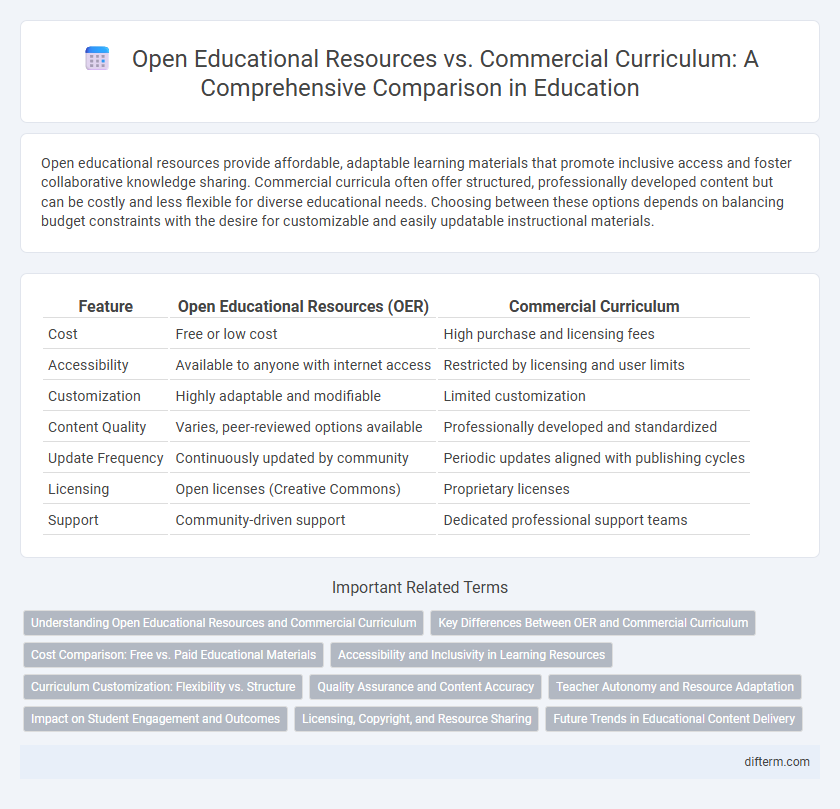Open educational resources provide affordable, adaptable learning materials that promote inclusive access and foster collaborative knowledge sharing. Commercial curricula often offer structured, professionally developed content but can be costly and less flexible for diverse educational needs. Choosing between these options depends on balancing budget constraints with the desire for customizable and easily updatable instructional materials.
Table of Comparison
| Feature | Open Educational Resources (OER) | Commercial Curriculum |
|---|---|---|
| Cost | Free or low cost | High purchase and licensing fees |
| Accessibility | Available to anyone with internet access | Restricted by licensing and user limits |
| Customization | Highly adaptable and modifiable | Limited customization |
| Content Quality | Varies, peer-reviewed options available | Professionally developed and standardized |
| Update Frequency | Continuously updated by community | Periodic updates aligned with publishing cycles |
| Licensing | Open licenses (Creative Commons) | Proprietary licenses |
| Support | Community-driven support | Dedicated professional support teams |
Understanding Open Educational Resources and Commercial Curriculum
Open Educational Resources (OER) provide freely accessible, customizable learning materials that promote equitable education and support diverse learning styles, contrasting with commercial curriculum which often involves proprietary content and licensing fees. OER fosters collaborative development and continuous updating by educators worldwide, enhancing relevance and adaptability compared to fixed, publisher-controlled commercial curricula. The cost-effectiveness and flexibility of OER make it a strategic choice for institutions aiming to reduce expenses while maintaining educational quality.
Key Differences Between OER and Commercial Curriculum
Open Educational Resources (OER) provide free, flexible access to instructional materials that can be adapted and redistributed by educators, promoting equitable learning opportunities worldwide. Commercial curricula typically involve copyrighted content with restricted usage, requiring purchase and licensing fees that limit adaptability and dissemination. The key differences center on cost, accessibility, and the ability to customize content, with OER emphasizing openness and collaboration versus the proprietary nature of commercial materials.
Cost Comparison: Free vs. Paid Educational Materials
Open educational resources (OER) provide high-quality learning materials at no cost, significantly reducing expenses for students and educators compared to commercial curricula, which often involve substantial purchase or licensing fees. Institutions adopting OER can allocate funds towards enhancing instructional support rather than acquiring costly textbooks and modules. Despite the initial investment in adapting OER, the long-term savings surpass the recurring costs associated with paid educational materials.
Accessibility and Inclusivity in Learning Resources
Open Educational Resources (OER) significantly enhance accessibility by providing free, adaptable materials that accommodate diverse learning needs and socio-economic backgrounds, unlike commercial curricula which often impose cost barriers and limited customization. Inclusive design in OER supports varied learning styles and disabilities through multilingual content, multimedia formats, and culturally relevant materials. This fosters equitable educational opportunities and empowers learners globally by removing restrictions linked to proprietary content.
Curriculum Customization: Flexibility vs. Structure
Open educational resources (OER) offer unmatched curriculum customization, allowing educators to modify content to fit diverse learning styles and local contexts, promoting flexibility and inclusiveness. Commercial curricula typically provide structured, standardized content designed to meet specific educational standards, ensuring consistency but limiting adaptability. This contrast highlights a crucial decision point for schools balancing the need for tailored learning experiences against the benefits of a cohesive, predefined curriculum framework.
Quality Assurance and Content Accuracy
Open educational resources (OER) undergo continuous peer review and collaborative updates, enhancing quality assurance through transparency and collective expertise. Commercial curricula often rely on proprietary review processes with standardized quality controls but may lack the adaptability and rapid content accuracy updates found in OER. Ensuring content accuracy in education requires balancing rigorous validation methods with timely revisions, where OER's open nature promotes current and relevant material compared to the fixed updates of commercial offerings.
Teacher Autonomy and Resource Adaptation
Open Educational Resources (OER) enhance teacher autonomy by providing freely accessible, editable materials that educators can customize to meet diverse classroom needs, unlike commercial curricula that often restrict modification. OER facilitates resource adaptation through flexible licensing, allowing teachers to tailor content to student learning styles and cultural contexts. Commercial curricula typically limit adaptation, constraining instructional creativity and responsiveness to specific educational environments.
Impact on Student Engagement and Outcomes
Open educational resources (OER) foster higher student engagement by providing diverse, customizable materials that adapt to varied learning styles, enhancing comprehension and retention. Research indicates students using OER achieve comparable or improved academic outcomes compared to commercial curriculum users, often benefiting from immediate access and cost savings. The flexibility and inclusivity of OER contribute to increased motivation and active participation, crucial factors in successful learning experiences.
Licensing, Copyright, and Resource Sharing
Open educational resources (OER) offer flexible licensing, typically under Creative Commons, allowing free use, modification, and distribution, while commercial curriculum often involves restrictive copyright and licensing agreements limiting access and sharing. OER promotes collaborative resource sharing and adaptation across educational institutions, enhancing accessibility and customization for diverse learning needs. In contrast, commercial materials require purchase and adherence to strict usage terms, restricting educators' ability to modify content or share resources freely.
Future Trends in Educational Content Delivery
Open educational resources (OER) are increasingly favored for their flexibility, cost-efficiency, and adaptability in personalized learning environments, contrasting with traditional commercial curricula that often lack real-time updates and customization. Advances in artificial intelligence and augmented reality are driving the shift toward interactive, immersive educational content, enabling dynamic, student-centered learning experiences. Data analytics integration in OER platforms enhances adaptive learning pathways, forecasting a future where content delivery is highly tailored and accessible across diverse digital ecosystems.
open educational resources vs commercial curriculum Infographic

 difterm.com
difterm.com